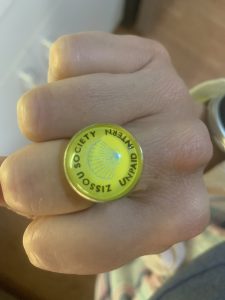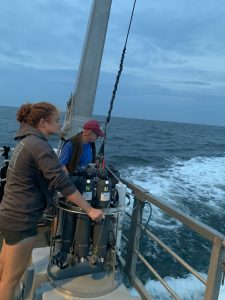Adventures in the Gulf of Maine – Part 3
This is the third of four posts about our field campaign in the Gulf of Maine during Spring/Summer 2023.
Our goal was to gain insight into the prevalence of mixotrophy in the Gulf of Maine and the potential importance of mixotrophs in supporting copepod populations. We had been planning to sample at three times in the season. Our first trip (in April) was exhausting but successful. Our second trip (in June) was plagued by rough weather, and we were only able to sample a subset of our desired stations. July was our third/final sampling window, and we were hoping to end on a high note.
We started out in a festive mood. Our core scientific team (Becky, Phil and me) would be joined by Research Associate Rodrigo Zuñiga and PEP researcher Cameron Johnson. Rodrigo had proved invaluable in his first trip out with us last month, and I was excited to give Cameron a chance t o see how we collected the samples he had been working on this summer. I was convinced that I could fend off seasickness if I took my medicine, skipped lunch, and wore my magic team Zissou ring (long story short: no such luck).
o see how we collected the samples he had been working on this summer. I was convinced that I could fend off seasickness if I took my medicine, skipped lunch, and wore my magic team Zissou ring (long story short: no such luck).

One good cast!
We left the dock around 5:30 in the evening, got on station by 8:45 and deployed the CTD to collect hydrographic data about the water column. Unfortunately, that was the last CTD profile were able to do that night. There was a malfunction in the communication between the CTD and the ship. We had one good profile and were able to collect the water from the rosette. But we still needed water for our experiments. Luckily the ship had a Niskin bottle and messenger….so we deployed a single niskin bottle over and over until we got the water we needed. It was sort of relaxing in a weird way. Once we had our water, we towed for zooplankton (no problems this time). Without any way to do hydrographic profiling at any other stations, we had no choice but to wrap it up and head back to shore.
I was disappointed to be heading home with only one of three stations sampled, and wondered if we could do a bit better. As we were leaving the ship, I asked the captain if he would be willing to take us back out to our inshore station next week. He was game, so I made a mental note to brace myself for doing it all over again next week.
Becky went straight back home with seawater samples (to measure mixotrophy activity) and the rest of us headed to the lab. We spent the rest of the night setting up incubations from our zooplankton samples (we finished around 7 am, so it felt like a bit of a blessing to have only one sample to contend with). Compared with our previous sample at this station (back in April), Calanus was still abundant but was now dominated by large copepodites rather than adults. Centropages was more abundant than we had seen at this station in April and was represented by a mixture of stages. We noticed that some of the animals were a bit sluggish in the lab and wondered if there might be stress effect. Unfortunately, the next day we also observed almost no egg production. This didn’t make sense to us based on previous studies in the area, so it seems that something had gone awry in our incubations, but no worries– we have a ‘Plan B’.